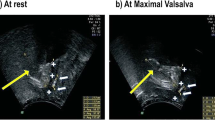Abstract
Aim
The object was to evaluate whether the degree of experience for the tension-free vaginal tape (TVT) procedures influenced the early results of the suprapubic arc (SPARC) sling procedure.
Materials and methods
We performed the TVT from March 1999 to May 2003 and SPARC from June to April 2004 by experienced surgeon (A) and inexperienced surgeon (B), respectively. Patients were divided as four subgroups: first 50 patients who underwent the TVT by surgeon A (TVT A); first 15 patients who underwent the TVT by surgeon B (TVT B); first 50 patients who underwent the SPARC by surgeon A (SPARC A); first 15 patients who underwent the SPARC by surgeon B (SPARC B).
Results
Bladder perforations were noted in 4 (8.5%) in the TVT A group and 2 (13.3%) in the TVT B group, respectively (P = 0.626). There was no bladder perforation occurred in the SPARC A and B groups. The rates of transient postoperative urinary retention were 6.4% in the TVT A group and 0.0% in the TVT B group, respectively (P = 1.000). No retention occurred in the SPARC A and B groups. Stress urinary incontinence was cured by 89.4% in the TVT A group and 80.0% in the TVT B group, respectively (P = 0.388). Similar success rates were found in the SPARC A (85.4%) and SPARC B (92.3%) group (P = 1.000).
Conclusion
Our findings suggest that the degree of experience for the TVT procedure does not influence the results of the SPARC procedure during the learning phase.
Similar content being viewed by others
References
Klutke C, Siegel S, Carlin B, et al (2001) Urinary retention after tension-free vaginal tape procedure: incidence and treatment. Urology 58:697–701
Ulmsten U, Henriksson L, Johnson P, et al (1996) An ambulatory surgical procedure under local anesthesia for treatment of female urinary incontinence. Int Urogynecol J 7:81–86
Ulmsten U, Falconer C, Johnson P, et al (1998) A multicenter study of tension-free vaginal tape (TVT) for surgical treatment of stress urinary incontinence. Int Urogynecol J 9:210–213
Ulmsten U, Johnson P, Rezapour M (1999) A three-year follow up of tension free vaginal tape for surgical treatment of female stress urinary incontinence. Br J Obstet Gynaecol 106:345–350
Wang AC, Lo TS (1998) Tension-free vaginal tape. A minimally invasive solution to stress urinary incontinence in women. J Reprod Med 43:429–434
Deval B, Levardon M, Samain E, et al (2003) A French multicenter clinical trial of SPARC for stress urinary incontinence. Eur Urol 44:254–258
de Leval J (2003) Novel surgical technique for the treatment of female stress urinary incontinence: transobturator vaginal tape inside-out. Eur Urol 44:724–730
Groutz A, Gordon D, Wolman I, et al (2002) Tension-free vaginal tape for stress urinary incontinence: Is there a learning curve? Neurourol Urodyn 21:470–472
Lebret T, Lugagne PM, Herve JM, et al (2001) Evaluation of tension-free vaginal tape procedure. Its safety and efficacy in the treatment of female stress urinary incontinence during the learning phase. Eur Urol 40:543–547
Ingelman-Sundberg A, Ulmsten U (1983) Surgical treatment of female urinary stress incontinence. Contrib Gynecol Obstet 10:51–69
Abrams P, Cardozo L, Fall M, et al (2003) The standardisation of terminology in lower urinary tract function: report from the standardisation sub-committee of the International Continence Society. Urology 61:37–49
Juma S, Little NA, Raz S (1993) Evaluation of stress urinary incontinence. In: Buchsbaum HJ, Schmidt JD (eds) Gynecologic and obstetric urology. Saunders, Philadelphia, pp 251–263
Bump RC, Coates KW, Cundiff GW (1997) Diagnosing intrinsic sphincter deficiency: comparing urethral closure pressure, urethral axis, and Valsalva leak point pressure. Am J Obstet Gynecol 177:303–310
Madjar S, Tchetgen MB, Van Antwerp A (2002) Urethral erosion of tension-free vaginal tape. Urology 59:601
Shah PJR (2003) A French multicenter clinical trial of SPARC for stress urinary incontinence: editorial comment. Eur Urol 44:258–259
Author information
Authors and Affiliations
Corresponding author
Rights and permissions
About this article
Cite this article
Paick, JS., Oh, J.G., Shin, J.W. et al. Does the degree of experience for the tension-free vaginal tape procedure influence the results of the suprapubic arc sling procedure during the learning phase?. Int Urol Nephrol 39, 1079–1084 (2007). https://doi.org/10.1007/s11255-006-9156-8
Received:
Accepted:
Published:
Issue Date:
DOI: https://doi.org/10.1007/s11255-006-9156-8




